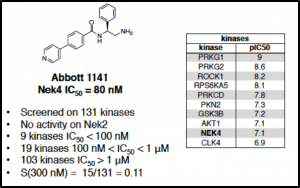Hello!
Recently, I co-authored a manuscript titled, “In depth analysis of kinase cross screening data to identify chemical starting points for inhibition of the Nek family of kinases” [http://pubs.rsc.org/en/content/articlelanding/2018/md/c7md00510e#!divAbstract]. As a part of this manuscript we identified several chemical starting points that can be used for the design of narrow spectrum and potent Nek kinase inhibitors.
One compound of particular interest is Abbott 1141:

Originally, designed as a Rho kinase (ROCK) inhibitor, Abbott 1141 inhibits Nek4 with an IC50 of 80 nM. Based on the available selectivity data, this compound inhibits 15 out of the 131 kinases it was screened, with IC50 values less than 300 nM. Furthermore, Abbott 1141 does not have any activity for Nek2.
Structurally, Abbott 1141 has a simple 4-pyridine substituted benzamide backbone; where the pyridine ring acts as the hinge binding group. Another feature of this compound is the presence of a chiral 2-amino 1-phenylethyl unit. Considering the structural simplicity of this compound, we envisioned that with relatively simple chemistry and easily accessible building blocks a diverse library of compounds can be rapidly synthesized.
Why Nek4?
Nek4 is a member of the Nek family of kinases (Nek1 to Nek11). There is very limited information known about the biological functions of Nek4. In 2010, Doles and co-worker showed that Nek4 deficiency is involved in microtubule homeostasis and either enhances or antagonizes the effect of drugs targeting microtubules. Recently Park and co-workers, showed that Nek4 is highly upregulated in lung and colon cancer and is associated with the apoptosis triggering tumor necrosis factor (TNF)-related apoptosis-inducing ligand (TRAIL) in lung cancers. [https://www.ncbi.nlm.nih.gov/pubmed?term=nek4%5BTitle%2FAbstract%5D] Compared to other members of the Nek family especially Nek2, Nek4 is extremely understudied. Thus, in order to unravel the functions of Nek4 and understand its implications in diseases, a potent and selective Nek4 inhibitor is required.
Accordingly, we have initiated a systematic Structure Activity Relationship (SAR) study on this compound with the following aims:
- Identify SAR trends with respect to potency at Nek4 and selectivity across the screenable kinome.
- Identify narrow spectrum and potent Nek4 compounds.
- Identify compounds and chemical starting points for other understudied kinases for the KCGS. [http://journals.plos.org/plosone/article?id=10.1371/journal.pone.0181585]
Moreover, due to the high homology between the Nek family members, another possible outcome of this project could be the identification of pan-Nek inhibitors.
The SAR approach that will be followed is shown below:

Our initial steps in this project are:
- To profile Abbott 1141 in a DiscoverX KINOMEscan assay to measure selectivity across the kinome.
- To investigate the importance of the chiral center by synthesis and screening of R-Abbott 1141 and rac-Abbott 1141.
- Synthesize and screen a negative control of Abbott 1141.
In my next updates, I will discuss the synthesis of analogs to execute our SAR plan. Stay tuned!
